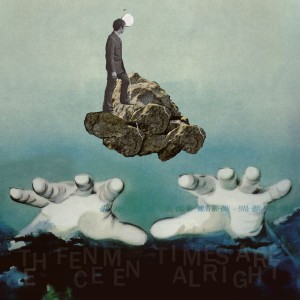
Artist: Elton John
Album: The Diving Board (2013)
The Tin Pan Alley Twins strike again, and strongly so. Elton’s recently released The Diving Board is a strong addition to a large, eclectic catalogue that spans five decades. Like many of his musical peers (of which there are few), he’s often saddled with the stereotype of being a legacy act – a touring, nostalgic jukebox of greatest hits. He may continue to sing “Your Song” at just about every performance, but he and lyricist Bernie Taupin are writing some of their strongest material almost fifty years after meeting. I’ve had The Diving Board since its 09.24 US release and can’t get enough.
[I wrote about his previous album The Union, a collaboration with Leon Russell, soon after its release here.]
The Diving Board features John continuing his relationship with producer T. Bone Burnett, which began with The Union. Also, like The Union, The Diving Board features quasi-Americana and gospel-tinged themes reminiscent of much of Elton’s early material. (If you’re not too familiar with his deep cuts, his second through fifth albums – Elton John, Tumbleweed Connection, Madman Across the Water, Honky Chateau – are rife with great piano-driven country rock songs.) Furthermore, The Diving Board is heavily piano-centric. While that may at first seem obvious, many of Elton’s albums feature such large bands and/or heavy production that his instrument is often obscured. Many of his early performances, including his US debut at The Troubadour in 1970 (also attended by T. Bone Burnett), featured a piano trio. In instrumentation and style, Elton is returning to his roots, even more so than with The Union.
The Union casts a small shadow here, mainly in tone. Though I’m sure that’s Burnett’s touch. Stylistically the album is a mix of The Union, Madman Across the Water, Tumbleweed Connection, and The Captain & The Kid. The album’s consistent core is the piano trio of Elton, bassist Raphael Saadiq, and drummer Jay Bellerose. (Bellerose also performed on The Union.) It’s a noticeable departure from Elton’s touring band, which features decades-long collaborators Davey Johnstone (guitar) and Nigel Olsson (drums, who has played with Elton since 1969’s Empty Sky). Other instruments – strings, brass, background vocals, occasional guitar – are used throughout the album, but sparingly so and without obscuring the core trio. When used, the guitar is still playing second to the piano, and the orchestral instruments are there primarily for texture. This relatively stripped down sound is more akin to a club than an arena or stadium. Make no mistake, however, because many of the songs groove hard.
Band aside, Elton himself sounds real nice. He long ago had to trade in his soaring tenor range for a silky baritone, and it’s on wonderful display here. This is evident right from the beginning with the gentle and nostalgic “Ocean’s Away,” the album’s overture featuring only Elton on voice and piano. Then, bit by bit, the rest of the the band joins in on the haunting but hard-driving “Oscar Wilde Gets Out.” This ode to the Irish writer is the sort of brooding saloon romp that conjures the best of The Union and Tumbleweed Connection. This is followed by the gospel-tinged “A Town Called Jubilee,” the first joyous number, with Taupin painting images of the open West. Taupin continues the Americana with “The Ballad of Blind Tom,” an ode to pianist Blind Tom Wiggins. The song’s narrative reads and sounds as if it were written for a musical, but it’s an effective standalone work. Elton keeps up the gospel- and old school country-influenced stylings on “Take This Dirty Water” and “Mexican Vacation (The Kids in the Candlelight).”
“Home Again,” the album’s first single, is a top shelf ballad that I’m sure will quickly find itself in his Greatest Hits canon. Single or not, it’s a crown jewel of the album and one of the best songs Elton’s written in years. “The New Fever Waltz” and “My Quicksand” are the other ballads, with the latter being the album’s weakest link for me. For those looking for a more recent “Elton sound” a la Songs From the West Coast or The Captain & The Kid, “Can’t Stay Along Tonight” and “Voyeur” scratch that adult contemporary itch. There are also three standalone instrumental interludes, each being a numbered “Dream.” None are as robust as “Funeral for a Friend,” but each provides a nice respite while moving the action along. The album closes with the title track, a mellow lounge number suggestive of a last call.
This could be my favorite of Elton’s late-era albums. If you’ve kept a safe distance from his recent output, this could be your foot in the door. As for me, I’m going to give it yet another spin…



